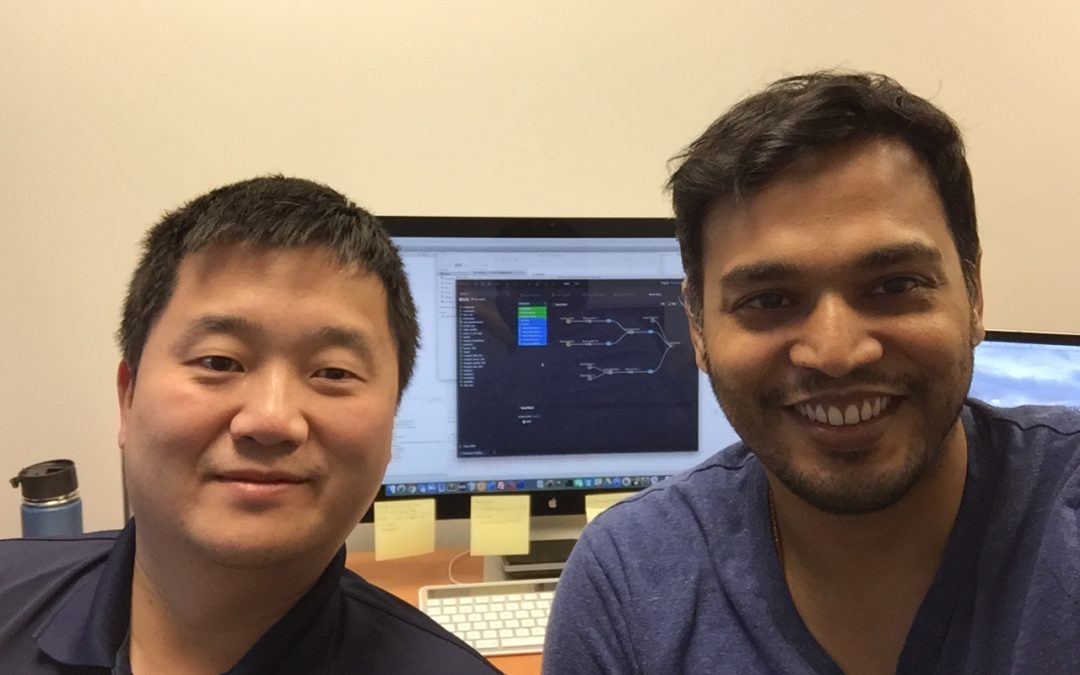FX Experience Has Gone Read-Only
I've been maintaining FX Experience for a really long time now, and I love hearing from people who enjoy my weekly links roundup. One thing I've noticed recently is that maintaining two sites (FX Experience and JonathanGiles.net) takes more time than ideal, and splits the audience up. Therefore, FX Experience will become read-only for new blog posts, but weekly posts will continue to be published on JonathanGiles.net. If you follow @FXExperience on Twitter, I suggest you also follow @JonathanGiles. This is not the end - just a consolidation of my online presence to make my life a little easier!
tl;dr: Follow me on Twitter and check for the latest news on JonathanGiles.net.

by Jonathan Giles | May 18, 2016 | Interviews
It’s been a long time since my last interview, but today I have an interview from Tai Hu and Ajo Abraham, who are working on some cool stuff that I wanted to share.
Hi guys – could you please introduce yourselves to the readers?
Sure, my name is Ajo and I founded Vero Analytics 2 years ago to make data prep easier for people, especially business analysts. Before that, I worked in big data and analytics for over 10 years at companies like Netflix, Google, and eBay.
And, I’m Tai Hu CTO of Vero Analytics. I’ve been developing Java applications for 2 decades at various companies in the Washington DC area. I also worked at Oracle which was a great experience.
So you’ve been working on your Vero Designer product for a few years now. What does Vero do?
Essentially, Vero allows you to drag and drop your way into a finely prepared dataset. You need well organized datasets to efficiently use visualization tools like Tableau, Qlik, and Microsoft Power Pivot. You also need enriched datasets to use in downstream Marketing automation tools. Right now the major options are bloated ETL (extract, transfer, load) software that are difficult to use or you have to hire data engineers. Neither are good options for many business teams, especially since ETL tools still require a great proficiency SQL and other programming paradigms.
With Vero you can wrangle and load data into databases, blend data across data sources, build complex data flows, and finally export data into target tables. No coding required. Vero does the query generation, the data transformation, and the data movement all without any code from the user. It is so effective and priced well that we have people now who are programmers using Vero. They are doing this because Vero saves them time when dealing with the pain that is data prep. We are currently working on exciting new exports including the ability to post data to any Rest end point. I think our users are going to love this. The use cases are endless. Email automation, advertising automation, customer on boarding etc.
Who do you think would benefit from your product?
Its really a cross functional application. Data is so pervasive now a days there are many categories of users. We mainly see Business Analysts, Business Intelligence developers, Visualization developers, and data engineers using our tools. Our customer industries span everything from Entertainment to Hospitality.
You built Vero with JavaFX – how did you find working with it?
Tai can speak to this better than I can.
SceneBuilder and CSS support are two major factors that brought us to JavaFX. Overall we had a very positive experience with JavaFX. I used to be a Swing developer and JavaFX property binding makes it a lot easier to keep model and UI in sync. Also JavaFX concurrency package allow us to create responsive UI without worrying about threading issues.
Did you always plan to use JavaFX? What motivated you to choose JavaFX over other technologies?
No. We looked at lots of options to make development fast. Options like node-webkit, Electron, Chrome Apps were all considered. Our plan all along was to build a desktop app, but originally thought a web tech environment would be better. In someways we still think that, since there are more web devs out there and a lot more community support. However, Java and JavaFX gave us two things that outweighed these concerns. Performance and JDBC. We rated our needs of both performance and jdbc connectivity to be paramount and that pretty much drove the decision. Besides that we really wanted to build a highly stylized UI that makes data approachable. JavaFx gave us that and we are so far happy with it.
I’ve heard you’ve had some amazing interest in your product already. First of all – congratulations. Secondly, can you speak more about who is using your app, and how they benefit.
Yes, definitely. The notable customers are Netflix and Mozilla. We are thrilled to have them as customers and we are very proud of that achievement. We launched our true MVP back in February of 2016 so this was great. Right now we are doing a project with Netflix to download and load data from any JSON end point into MySQL (we will also support Postgres and RedShift) using Vero. For the sake of full disclosure, Netflix is using our product to help with their internal app analytics not the massive datasets related to streaming.
Have you made use of any open source libraries or benefitted from the JavaFX community in any way? What are you feelings on Java on the client, and the community around it?
Yes, we used a couple of JavaFX open source libraries, such as DataFX, ControlsFX, and FontAwesomeFX. Those libraries definitely provide us a lot of quality widgets and icons. Overall we had a positive experience with Java desktop technology. However comparing to Web techonologies, JavaFX community has a way to go. I hope us being out here and being successful will motivate people. We also want to contribute and will do so as we grow.
How can the JavaFX community help?
Tell your buddies who are business analysts, business intelligence developers, or data engineers about Vero. While we have a few customers we still got a bit to go before we can be successful. We’ll take whatever help we can get :).
I’ve seen a few videos you’ve created that demonstrate Vero. Do you have one or two that you’d like the readers to watch?
Our awesome RedShift file loading demo and our super data blending demo.
Thanks for your time today. Did you have any final comments?
We want to thank the entire JavaFX community for their continued effort in making JavaFX a great client side platform. Certainly want to thank you for FXexperience and other folks for their contributions. Desktop apps are not going away and I think JavaFX has a great future as long as we push the boundaries.

by Jonathan Giles | Sep 18, 2014 | Interviews
Today I have an interview with Sean Phillips. For those new to this series, here are the people who have been interviewed so far:

Hi there. Thanks for taking the time to do this quick interview. Can you please introduce yourself?
Hey I am Sean Phillips and I live near Washington DC, USA. I work for a.i. solutions inc and we are a major NASA corporate partner. Additionally I am the founder of the free open source JavaFX 3D library F(X)yz. I received a 2013 Duke’s Choice award for my GEONS Ground Support System software.
Recently I contributed, along with Gerrit Grunwald, Mark Heckler, Jose Pereda and Carl Dea, to the book titled ‘JavaFX 8 Introduction by Example‘ by Apress publishing.
Is this your first time presenting at JavaOne, or are you a JavaOne veteran?
This will be my third JavaOne and second presenting. I suppose that makes me a veteran… I still have a free t-shirt with SUN logos on them from my first JavaOne. I presented at several sessions last year and was extremely fortunate to present live during the community keynote.
What was presenting at the keynote like compared to the technical sessions?
Well we had rehearsal and practiced our timing the night before. Henrik Stahl was the host for my portion and he’s great. Really sharp and quick on his feet up there. I was presenting NASA mission software so I thought I would have the coolest section but I was bookended by James Gosling’s Underwater Robots and Aditya Gupta’s exploding flying Minecraft Pigs. I had no chance! How can you compete with that??
What are you going to talk about at JavaOne this year?
This year I have a mix of sessions, ranging from JavaFX 3D to Lessons Learned in Mission Critical systems.
I am excited by my NASA Software Development on the Eights session where a team of my colleagues and I will be discussing and demonstrating some of the software we develop for our NASA missions.
What type of missions are you working on?
The team I am bringing and my company a.i. solutions provide support for a long list of missions and launches ranging from James Webb Space Telescope to the International Space Station. A strong cross-section of those missions will be discussed at JavaOne by us this year.
Do you have any big announcements or releases planned leading up to (or at) JavaOne? Can you give any hints?
No hints, I will just tell you. Jason Pollastrini (@jdub1581, Co-founder of F(X)yz) and I have just open sourced our JavaFX 3D library. Unfortunately Jason couldn’t make JavaOne this year but I will be demonstrating the new features that provide a lot of support that JavaFX 3D does have within its base packages. We are really proud of the work and we moving ahead towards making everything from better 3D data visualizations to all the basics of a 3D Game engine. A shout out to Jason: He’s really bumped the project forward. Anybody on the west coast in need of a graphics/3D guy he’s fantastic!
Is there anything else you’d like to discuss?
Find me at the Taylor Street cafe after 2pm!

by Jonathan Giles | Sep 16, 2014 | Interviews
Today I have an interview with Hendrik Ebbers. For those new to this series, here are the people who have been interviewed so far:
 Hi there. Thanks for taking the time to do this quick interview. Can you please introduce yourself?
Hi there. Thanks for taking the time to do this quick interview. Can you please introduce yourself?
Sure 🙂
I’m Hendrik Ebbers and live in Dortmund, Germany and work for Canoo Engineering AG. In addition I’m the lead of JUG Dortmund. My main focus is primarily in the areas of JavaFX, Middleware and DevOps. I have a website (www.guigarage.com) on that I try to blog about UI related topics. In the last time most of the post are about JavaFX and enterprise development. If you are interested in this you should visit my blog or follow me 🙂 (@hendrikEbbers)
For JavaOne 2014 JavaFX is my core topic. As a Featured Speaker I will have 6 talks at JavaOne this year. Next to this Oracle Press released my “Mastering JavaFX 8 Controls” book this summer.
Is this your first time presenting at JavaOne, or are you a JavaOne veteran?
No to both 🙂
I was speaking at JavaOne last year the first time. I had 3 talks about JavaFX. It was an awesome week and I can’t wait to be there again.
What are you going to talk about at JavaOne?
As already said my main topic will be JavaFX. I’ve prepared some talks that introduce different subtopics like JavaFX enterprise development or styling with CSS. A complete list of all my talks can be found at my blog: http://www.guigarage.com/2014/08/javaone-2014-sessions/
In addition I try to give some previews and sneak peek of my talks at guigarage. Currently there are two previews:
http://www.guigarage.com/2014/09/javaone-2014-preview/
http://www.guigarage.com/2014/09/javaone-preview-enterprise-javafx/
Do you have any big announcements or releases planned leading up to (or at) JavaOne? Can you give any hints? 😉
Let’s start talking about releases. We plan to release DataFX 8 at JavaOne. With version 8 DataFX will contain 5 modules: core, data reader, flow, injection & web socket. We have a DataFX 8 talk at JavaOne in that we want to introduce all the features and show some demos. I hope that the JavaFX community will like what we did the last year.
In addition I created a collection of small but helpful JavaFX modules. This set of modules is called “Guigarage JavaFX Collections“ and I will release a first version at JavaOne. In all of my talks at minimum one of the modules is used to code some cool demos. I don’t want to talk to much about the content of this project because I will introduce it in my talks. But I can say that there are modules for animations, styling, custom controls and some other core topics.
Is there anything else you’d like to discuss?
Come to JavaOne! It’s the biggest and coolest Java Conference in the world. Oh, and visit my talks 😀
For all the people who can’t visit JavaOne I plan to release all demos and slides directly after the conference. In addition I’m currently writing some descriptions for the modules of the “Guigarage JavaXF Collections” set that will be released on guigarge after JavaOne.
Thanks for taking time out of your day to answer these questions! All the best for your JavaOne talks!

by Jonathan Giles | Sep 9, 2014 | Interviews
Today I have an interview with Johan Vos. For those new to this series, here are the people who have been interviewed so far:
![e6fy0qy8tc5n996l2cbr[1]](http://fxexperience.com/wp-content/uploads/2014/09/e6fy0qy8tc5n996l2cbr1.jpeg) Hi there. Thanks for taking the time to do this quick interview. Can you please introduce yourself?
Hi there. Thanks for taking the time to do this quick interview. Can you please introduce yourself?
I am Johan Vos, a Java Champion working with Java on the server (Java EE) and Java on the client (JavaFX). I am the lead author of Pro JavaFX 8, co-founder of DataFX, and maintainer of the JavaFX Android port.
Is this your first time presenting at JavaOne, or are you a JavaOne veteran?
Between 1999 and now, I only missed one JavaOne edition that overlapped with the birth of my daughter.
What are you going to talk about at JavaOne?
I have 2 sessions this year: CON1804 about JavaFX Android and CON3640 about DataFX. In CON1804, we will show how to run your JavaFX Applications on Android devices. The target area of JavaFX developers becomes much, much larger now that you can also deploy JavaFX Applications on Android devices. The porting effort is a work in progress, we will show the current status and our roadmap plans.
In CON3640, we will talk about how to get real-world enterprise Data in your applications and back to the original source, and how to handle the flow in a complex application. JavaFX provides a powerful UI for developing Java Client applications, and DataFX extends this by adding features required for developing Enterprise Applications that can be used on Desktop, mobile and embedded.
Do you have any big announcements or releases planned leading up to (or at) JavaOne? Can you give any hints?
I realize people come from all over the world, and spend time and money on the JavaOne conference. They deserve more than just a tutorial. For those interested in Java on mobile devices, I’m doing my best to make it an exciting conference.
Is there anything else you’d like to discuss?
Make sure you go to JavaOne. It is the biggest Java Community conference. There is a reason why I try to attend every single year. There is so much information, so much discussions, and your head will be filled with ideas by the end of the week. If you’re a Java developer, JavaOne is the place to be. Oh, and we should go back to the Moscone conference center one day. The more people attending JavaOne, the higher the chances we will take the Moscone back.

by Jonathan Giles | Sep 7, 2014 | Interviews
Today I have an interview with Carl Dea. For those new to this series, here are the people who have been interviewed so far:
Let’s get into the interview! Enjoy 
![8c99d2a4-9261-4f27-8222-b406c7eefafc_400x400[1]](http://fxexperience.com/wp-content/uploads/2014/09/8c99d2a4-9261-4f27-8222-b406c7eefafc_400x4001.png) Hi there. Thanks for taking the time to do this quick interview. Can you please introduce yourself?
Hi there. Thanks for taking the time to do this quick interview. Can you please introduce yourself?
Hi, I am Carl Dea. I want to first thank you and the other JavaFX teams at Oracle for not only building a great graphics toolkit but helping grow the JavaFX community. I work for Objective Solutions Inc. as a software engineer & UI developer by day and an avid JavaFX enthusiast by night. I and others (Gerrit Grunwald, Mark Heckler, Jose Pereda and Sean Philips) have recently finished authoring the book titled ‘JavaFX 8 Introduction by Example‘ by Apress publishing.
What was your goal in writing the book?
The book is the second edition of the JavaFX 2.0 Intro by Example book. JavaFX 8 Introduction by Example aims at providing easy to follow examples while introducing new features in JavaFX 8 and learning the new Java 8 language features. Of course given the huge feature set of JavaFX 8 and Java 8 language features the book couldn’t cover everything. But hopefully, this will allow readers to quickly get up to speed and begin to build rich client-side applications in JavaFX.
Is this your first time presenting at JavaOne, or are you a JavaOne veteran?
Yes, this is my first time speaking at JavaOne. So, hopefully everything goes as planned. Not to jump the subject but I am reminded of a a funny comic strip depicting what could go wrong during a presentation:
![phd012113s[1]](http://fxexperience.com/wp-content/uploads/2014/09/phd012113s1.gif)
What are you going to talk about at JavaOne?
I’ve been working on a talk for JavaOne regarding a live editor tool for developers to quickly prototype JavaFX UIs and visualizations. The session is titled JavaFX Coding Playground (JavaFX-Based Live Editor Tool). The tool will allow developers to execute code without the need of compiling Java code by using the new JavaScript engine Nashorn in JDK 8. In the session attendees will learn how to code UIs with JavaScript, FXML, JavaFX CSS styling. Also, they will learn how to use external libraries such as JFXtras, Enzo and your open source project that you started called ControlsFX.
Do you have any big announcements or releases planned leading up to (or at) JavaOne? Can you give any hints? 
The JavaFX Coding Playground (Live editor) tool to be demonstrated in the talk FX Playground will soon be open sourced and should be available before the talk (end of Sept.). The public will get a chance to perform a git clone to download the source code to be built and executed. Binary distributions will come later.
Is there anything else you’d like to discuss?
Yes,
I wanted to also point out that FX Playground’s features that I mentioned earlier doesn’t stop there! It has new support for many other languages (not just JavaScript (Nashorn)).
What are all languages that you currently support?
JavaScript (Nashorn), Groovy, GroovyFX, Python (Jython), Ruby (JRuby), Clojure, and Scala.
Why are you supporting so many languages?
I realized something about the software programming world is that it is made up of people with different backgrounds (programming languages). Having these different backgrounds I often sense programmers tend to be more comfortable with certain languages than others (dogma). So, given that these popular languages sit on top of the JVM (based on JSR 223) the developer can access and reap all the benefits of the JavaFX APIs. Therefore, anyone proficient in any of the languages mentioned above will be able to quickly prototype user interfaces, animations or any other type of visualization using JavaFX.
Thanks for taking time out of your day to answer these questions! All the best for your JavaOne talks!
Thank you Jonathan. It was my pleasure. I wish you the best on your talks also!

by Jonathan Giles | Sep 4, 2014 | Interviews
Today I have an interview with David Grieve. For those new to this series, here are the people who have been interviewed so far:
Let’s get into the interview! Enjoy 🙂
 Hi there. Thanks for taking the time to do this quick interview. Can you please introduce yourself?
Hi there. Thanks for taking the time to do this quick interview. Can you please introduce yourself?
Sure. I’m a member of the JavaFX team at Oracle. I’m primarily responsible for the CSS implementation, but I’ll take credit for almost anything that makes you say, “Wow. Cool!” As far as street cred, I’ve been coding in Java since the 1.0 days.
Is this your first time presenting at JavaOne, or are you a JavaOne veteran?
The first time I presented at JavaOne, I gave a part of a talk on JavaFX script. I’ve given several talks since then.
What are you going to talk about at JavaOne?
I have three presentations, two of which are centered around CSS. One is a tutorial on the JavaFX CSS API and another is on ‘hacking’ unsupported CSS features like transitions. The third presentation is a BOF where I hope to share some of what I’ve learned about debugging JavaFX.
Do you have any big announcements or releases planned leading up to (or at) JavaOne? Can you give any hints? 😉
I’m not Larry Ellison, so I’m not allowed to say anything. But then again, anything I would say is public knowledge.
Thanks for taking time out of your day to answer these questions! All the best for your JavaOne talks!
![]()
![8c99d2a4-9261-4f27-8222-b406c7eefafc_400x400[1]](http://fxexperience.com/wp-content/uploads/2014/09/8c99d2a4-9261-4f27-8222-b406c7eefafc_400x4001.png) Hi there. Thanks for taking the time to do this quick interview. Can you please introduce yourself?
Hi there. Thanks for taking the time to do this quick interview. Can you please introduce yourself?![phd012113s[1]](http://fxexperience.com/wp-content/uploads/2014/09/phd012113s1.gif)
![]()







